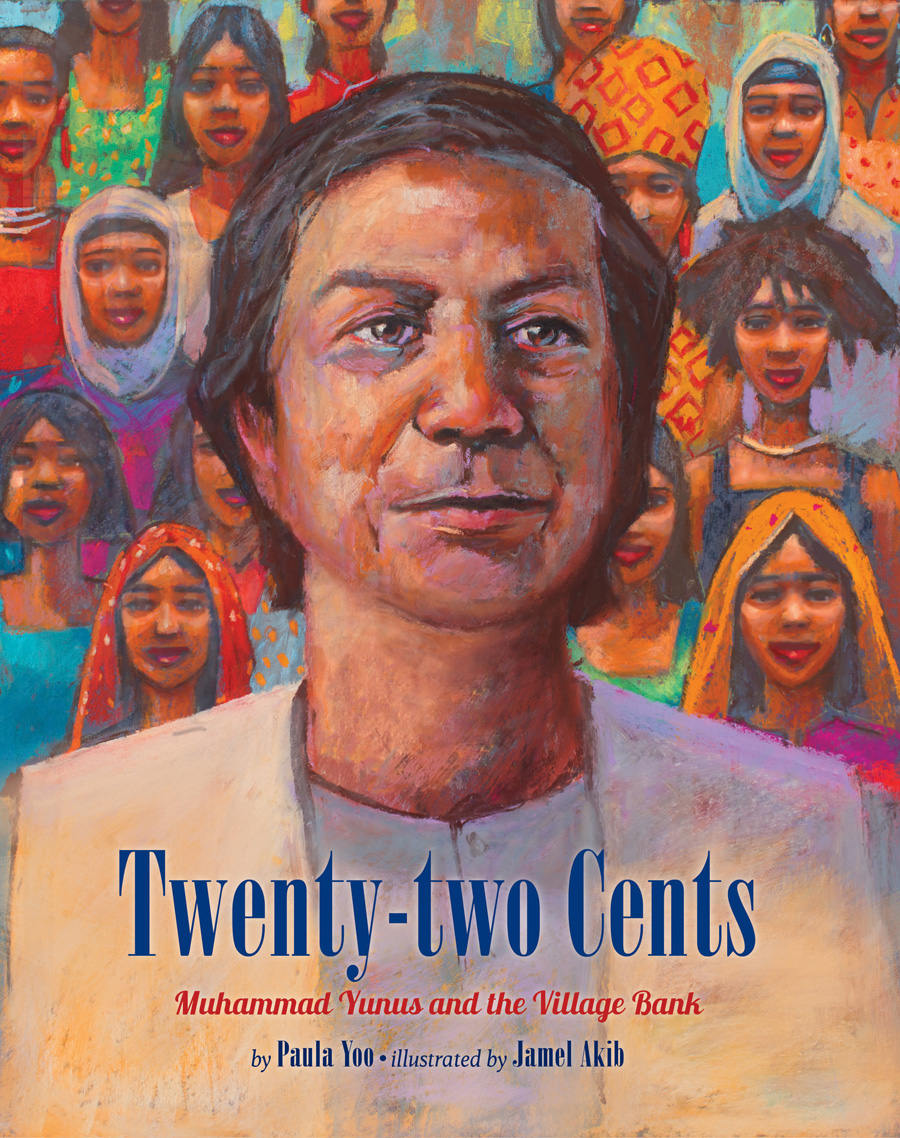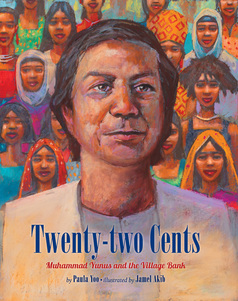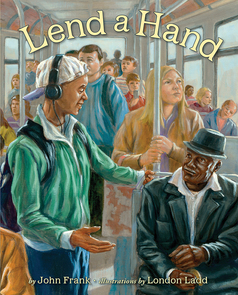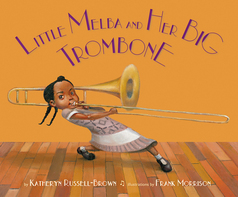Today is Human Rights Day. It commemorates the day in 1948 when the United Nations General Assembly adopted the Universal Declaration of Human Rights. The Universal Declaration of Human Rights lists basic rights and freedoms that every person should get, regardless of race, religion, sexual orientation, or gender.
 Books are a great way for readers to learn about history and culture, and develop empathy for other people.
Books are a great way for readers to learn about history and culture, and develop empathy for other people.
Our Human Rights collection explores the issues of human rights around the world and in the United States, and the great leaders who have fought to protect those rights:
Twenty-two Cents : Growing up in Bangladesh, Muhammad Yunus witnessed extreme poverty. He later founded Grameen Bank, a bank which uses microcredit, lending small amounts of money, to help lift people out of poverty. In 2006, Dr. Yunus was awarded the Nobel Peace Prize.
: Growing up in Bangladesh, Muhammad Yunus witnessed extreme poverty. He later founded Grameen Bank, a bank which uses microcredit, lending small amounts of money, to help lift people out of poverty. In 2006, Dr. Yunus was awarded the Nobel Peace Prize.
Brothers in Hope: Thousands of boys from southern Sudan walk hundreds of miles to seek safety, from Ethiopia to Kenya. This inspiring story is based on the true events of the Lost Boys of Sudan.
When the Horses Ride By: These poems from the point of view of children during times of war let readers experience the resilience and optimism that children who go through these situations experience.
Irena’s Jars of Secrets: Irena Sendler, a social worker born to a Polish Catholic family, smuggled clothing and medicine into jewish ghettos during WWII and then started to smuggle Jewish children out of the ghettos. Hoping to reunite them with their families, Irena kept lists of children’s names in jars.
John Lewis in the Lead: After high school, John Lewis joined Dr. King and other civil rights leaders to peacefully protest and fight against segregation. In 1986, John Lewis was elected to represent Georgia in Congress, where he continues to serve today.
A Place Where Sunflowers Grow: This bilingual Japanese-English picture book depicts life in a Japanese interment camp inspired by author Amy Lee-Tai’s family’s experiences during WWII. Young Mari wonders if she’ll be able to come up with anything to draw in a place where nothing beautiful grows.

Seeds of Change: As a young girl, Wangari Maathai was taught to respect nature and people. She excelled in science and later studied abroad in the United States. When she returned home, she helped promote the rights of women and also began to plant trees to replace those that had been cut down. Wangari Maathai became the first African woman to win a Nobel Peace prize in 2004.
Etched in Clay: This biography in verse follows the life of Dave the Potter, an enslaved young man in South Carolina who engraved poems into the pots he sculpted despite the harsh anti-literacy laws of the time.
Yasmin’s Hammer: Yasmin and her family are refugees in Bangladesh. Young Yasmin works at a brick yard to help her family out, but she longs for the day when she can attend school.
A Song for Cambodia: This the inspirational true story of Arn Chorn-Pond, who was sent to a work camp by the Khmer Rouge regime in Cambodia. His heartfelt music created beauty in a time of darkness and turned tragedy into healing.
The Mangrove Tree: Dr. Gordon Sato, himself a survivor of a Japanese Internment Camp, travels to an impoverished village in Eritrea and plants mangrove trees to help the village of Harigogo become a self-sufficient community.
Want to own this book list? Purchase the whole collection here.
More resources
Is Staff Diversity Training Worth It?
Interpreting César Chávez’s Legacy with Students
7 Core Values to Celebrate During Black History Month
Why You Should See Selma
11 Educator Resources for Teaching Children About Latin American Immigration and Migration
The Opposite of Colorblind: Why it’s essential to talk to children about race
Selection Is Privilege
Protesting Injustice Then and Now
Thoughts on Ferguson and Recommended Resources
Character Day: Taking a Look at the Traits Needed to Do What’s Right
Books for Children and Educators About Kindness
Infographic: 10 Ways to Lend a Hand on #GivingTuesday
 Paula Yoo is a children’s book writer, television writer, and freelance violinist living in
Paula Yoo is a children’s book writer, television writer, and freelance violinist living in Los Angeles. Her latest book, Twenty-two Cents: Muhammad Yunus and the Village Bank, was released last month. Twenty-two Cents is about Muhammad Yunus, Nobel Peace Prize winner and founder of Grameen Bank. He founded Grameen Bank so people could borrow small amounts of money to start a job, and then pay back the bank without exorbitant interest charges. Over the next few years, Muhammad’s compassion and determination changed the lives of millions of people by loaning the equivalent of more than ten billion US dollars in micro-credit. This has also served to advocate and empower the poor, especially women, who often have limited options. In this post, we asked her to share advice on what’s she’s learned about banking, loans, and managing finances while writing Twenty-two Cents.
Los Angeles. Her latest book, Twenty-two Cents: Muhammad Yunus and the Village Bank, was released last month. Twenty-two Cents is about Muhammad Yunus, Nobel Peace Prize winner and founder of Grameen Bank. He founded Grameen Bank so people could borrow small amounts of money to start a job, and then pay back the bank without exorbitant interest charges. Over the next few years, Muhammad’s compassion and determination changed the lives of millions of people by loaning the equivalent of more than ten billion US dollars in micro-credit. This has also served to advocate and empower the poor, especially women, who often have limited options. In this post, we asked her to share advice on what’s she’s learned about banking, loans, and managing finances while writing Twenty-two Cents.
What are some reasons why someone might want to take out a loan? Why wouldn’t banks loan money to poor people in Bangladesh?
PAULA: People will take out a loan when they do not have enough money in their bank account to pay for a major purchase, like a car or a house. Sometimes, they will take out a loan because they need the money to help set up a business they are starting. Other times, loans are also used to help pay for major expenses, like unexpected hospital bills for a family member who is sick or big repairs on a house or car. But asking for a loan is a very complicated process because a person has to prove they can pay the loan back in a reasonable amount of time. A person’s financial history can affect whether or not they are approved for a loan. For many people who live below the poverty line, they are at a disadvantage because their financial history is very spotty. Banks may not trust them to pay the loan back on time.
In addition, most loans are given to people who are requesting a lot of money for a very expensive purchase like a house or a car. But sometimes a person only needs a small amount of money – for example, a few hundred dollars. This type of loan does not really exist because most people can afford to pay a few hundred dollars. But if you live below the poverty line, a hundred dollars can seem like a million dollars. Professor Yunus realized this when he met Sufiya Begum, a poor woman who only needed 22 cents to keep her business of making stools and mats profitable in her rural village. No bank would loan a few hundred dollars, or even 22 cents, to a woman living in a mud hut. This is what inspired Professor Yunus to come up with the concept of “microcredit” (also known as microfinancing and micro banking).
In TWENTY-TWO CENTS, microcredit is described as a loan with a low interest rate. What is a low interest rate compared to a high interest rate?
PAULA: When you borrow money from a bank, you have to pay the loan back with an interest rate. The interest rate is an additional amount of money that you now owe the bank on top of the original amount of money you borrowed. There are many complex math formulas involved with calculating what a fair and appropriate interest rate could be for a loan. The interest rate is also affected by outside factors such as inflation and unemployment. Although it would seem that a lower interest rate would be preferable to the borrower, it can be risky to the general economy. A low interest rate can create a potential “economic bubble” which could burst in the future and cause an economic “depression.” Interest rates are adjusted to make sure these problems do not happen. Which means that sometimes there are times when the interest rates are higher for borrowers than other times.

What is a loan shark?
PAULA: A loan shark is someone who offers loans to poor people at extremely high interest rates. This is also known as “predatory lending.” It can be illegal in several cases, especially when the loan shark uses blackmail or threats of violence to make sure a person pays back the loan by a certain deadline. Often people in desperate financial situations will go to a loan shark to help them out of a financial problem, only to realize later that the loan shark has made the problem worse, not better.
Did your parents explain how a bank works to you when you were a child? Or did you learn about it in school?
PAULA: I remember learning about how a bank works from elementary school and through those “Schoolhouse Rocks!” educational cartoons they would show on Saturday mornings. But overall, I would say I learned about banking as a high school student when I got my first minimum wage job at age 16 as a cashier at the Marshall’s department store. I learned how banking worked through a job and real life experience.
TWENTY-TWO CENTS is a story about economic innovation. Could you explain why Muhammad Yunus’s Grameen Bank was so innovative or revolutionary?
PAULA ANSWER: Muhammad Yunus’ theories on microcredit and microfinancing are revolutionary and innovative because they provided a practical solution on how banks can offer loans to poor people who do not have any financial security. By having women work together as a group to understand how the math behind the loan would work (along with other important concepts) and borrowing the loan as a group, Yunus’ unique idea gave banks the confidence to put their trust into these groups of women. The banks were able to loan the money with the full confidence in knowing that these women would be able to pay them back in a timely manner. The humanitarian aspect of Yunus’ economic theories were also quite revolutionary because it gave these poverty-stricken women a newfound sense of self-confidence. His theories worked to help break the cycle of poverty for these women as they were able to save money and finally become self-sufficient. The Nobel Committee praised Yunus’ microcredit theories for being one of the first steps towards eradicating poverty, stating, “Lasting peace cannot be achieved unless large population groups find ways in which to break out of poverty.”
 Twenty-two Cents: Muhammad Yunus and the Village Bank is a biography of 2006 Nobel Peace Prize winner Muhammad Yunus, who founded Grameen Bank and revolutionized global antipoverty efforts by developing the innovative economic concept of micro-lending.
Twenty-two Cents: Muhammad Yunus and the Village Bank is a biography of 2006 Nobel Peace Prize winner Muhammad Yunus, who founded Grameen Bank and revolutionized global antipoverty efforts by developing the innovative economic concept of micro-lending.
Filed under: Guest Blogger Post, Lee & Low Likes, Musings & Ponderings Tagged: bangladesh, banking, banks, Economics, grameen bank, loan shark, loans, microcredit, money, Muhammad Yunus, nobel peace prize, Paula Yoo, poverty 

The temperature has already started to drop and we’re seeing Halloween candy popping up in the grocery stores, so that means a new batch of books for the fall season! Here are three new picture books out this week. We can’t wait to hear what you think of them!
Lend a Hand: Poems About Giving

Ages 6–10 • $17.95 hardcover
978-1-60060-970-1
Lend a Hand is a collection of fourteen original poems, each emphasizing the compassion and the joy of giving. Representing diverse voices—different ages and backgrounds—the collection shows the bridging of boundaries between people who are often perceived as being different from one another. Written by John Frank and illustrated by London Ladd.
“At once familiar and slightly out of the box, these giving scenes gently suggest that the smallest acts can inspire and achieve great ends.” —Kirkus Reviews
Little Melba and Her Big Trombone

Ages 6–10 • $18.95 hardcover
978-1-60060-898-8
With three starred reviews (PW, School Library Journal, Kirkus Reviews), it’s clear that Melba Doretta Liston is “something special”! Brimming with ebullience and the joy of making music, Little Melba and Her Big Trombone is a fitting tribute to a trailblazing musician and a great unsung hero of jazz. Written by Katheryn Russell-Brown and illustrated by Frank Morrison.
“An excellent match of breezy text and dynamic illustrations tells an exhilarating story.”
—starred review, School Library Journal
Twenty-Two Cents: Muhammad Yunus and the Village Bank

Ages 6–10 • $18.95 hardcover
978-1-60060-658-8
Twenty-two Cents is an inspiring story of economic innovation and a celebration of how one person—like one small loan—can make a positive difference in the lives of many. Written by Paula Yoo and illustrated by Jamel Akib.
“Yoo makes the significance of Yunus’s contributions understandable, relevant, and immediate.” —Publishers Weekly
Filed under:
Book News,
New Releases Tagged:
children's books,
diverse books,
fall books,
fall releases,
Melba Doretta Liston,
Muhammad Yunus,
multicultural books 

 Books are a great way for readers to learn about history and culture, and develop empathy for other people.
Books are a great way for readers to learn about history and culture, and develop empathy for other people. : Growing up in Bangladesh, Muhammad Yunus witnessed extreme poverty. He later founded Grameen Bank, a bank which uses microcredit, lending small amounts of money, to help lift people out of poverty. In 2006, Dr. Yunus was awarded the Nobel Peace Prize.
: Growing up in Bangladesh, Muhammad Yunus witnessed extreme poverty. He later founded Grameen Bank, a bank which uses microcredit, lending small amounts of money, to help lift people out of poverty. In 2006, Dr. Yunus was awarded the Nobel Peace Prize.



 Paula Yoo is a children’s book writer, television writer, and freelance violinist living in
Paula Yoo is a children’s book writer, television writer, and freelance violinist living in
 Twenty-two Cents: Muhammad Yunus and the Village Bank is a biography of 2006 Nobel Peace Prize winner Muhammad Yunus, who founded Grameen Bank and revolutionized global antipoverty efforts by developing the innovative economic concept of micro-lending.
Twenty-two Cents: Muhammad Yunus and the Village Bank is a biography of 2006 Nobel Peace Prize winner Muhammad Yunus, who founded Grameen Bank and revolutionized global antipoverty efforts by developing the innovative economic concept of micro-lending.
